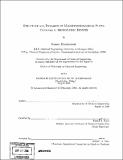Structure and dynamics of mangetorheological fluids confined in microfluidic devices
Author(s)
Haghgooie, Ramin
DownloadFull printable version (20.42Mb)
Alternative title
Structure and dynamics of MR confined in microfluidic devices
Other Contributors
Massachusetts Institute of Technology. Dept. of Chemical Engineering.
Advisor
Patrick S. Doyle.
Terms of use
Metadata
Show full item recordAbstract
Microfluidic devices and magnetorheological (MR) fluids have been two areas of intense research for several years. Traditionally, these two fields have remained separated from one another by scale. MR fluids are best known for their use in large-scale applications such as seismic dampers for the foundations of buildings. Recently however, there has been strong interest in utilizing the micro-structure formed by self-assembled MR fluids as structural components in microfluidic devices. MR fluids are composed of micron-sized paramagnetic colloids suspended in a non-magnetic carrier fluid. When an external magnetic field is applied to the MR fluid it induces dipole moments in the paramagnetic colloids causing them to interact and self-assemble into solid-like structures. In the past few years, self-assembled MR fluids have found use as structural components in a variety of micro-scale applications since their use provides an attractive alternative to traditional lithography as a means to create micro-scale structures. The advantages of using MR fluids include the ability to easily and inexpensively create sub-micron structures as well as the ability to create "dynamic structures" that can be controlled with an external magnetic field. (cont.) In order for self-assembled MR fluids to be useful as structural components in microfluidic devices, we must understand the mechanisms and parameters governing their self-assembly under the confinement induced by the microfluidic channels. In this thesis we present a series of studies merging the areas of microfluidics and MR fluids. The systems we studied are technologically relevant as well as ideal for understanding the fundamental processes at work in the self-assembly of MR fluids under confinement. Using the Brownian dynamics simulation technique as well as experimental studies with microfluidic channels, we have illuminated many of the governing physical mechanisms involved in the self-assembly of MR fluids confined in microfluidic channels. In particular, we determined that the channel dimensions play a crucial role in dictating both the final structure as well as the dynamics of the MR fluid structures in these systems. We performed a systematic study of the structure and dynamics of MR fluids confined in two-dimensional (2D) channels with an external magnetic field directed normal to the channel in order to produce a state-diagram for the system as a function of the channel width and the magnetic field strength (the two controlling thermodynamic parameters). (cont.) We further investigated the effects of the channel height and characterized the behavior of the system in the transition from quasi-2D to 3D microchannels. The behavior of the MR fluid structures in this transition region was found to depend heavily upon the volume fraction of the MR fluid and the height of the microchannel. We fully characterized the pore-size between clusters for dilute MR fluids self-assembled in quasi-2D microchannels, as it is an important parameter for microfluidic DNA mapping devices. Both the 2D and quasi-2D model systems provided valuable insight into the important mechanisms governing confined self-assembly. The impact of this work will be two-fold. Our study of the model systems of 2D channels and the transition from quasi-2D to 3D have made an important contribution to the literature on the physics of condensed matter systems. In particular, 2D colloidal systems are of great interest as models for self-assembly and phase transitions. Our work has illustrated how the presence of confining boundaries affects the behavior of 2D colloidal systems. Furthermore, the study of the quasi-2D system has shown how the interaction energy between MR fluid clusters dictates the structure that forms in this geometry. (cont.) In addition to the fundamental scientific questions we have addressed, our work will also have a broad impact on the design of microfluidic devices utilizing self-assembled MR fluids. We have illustrated this design process with two examples but the possibilities for merging microfluidic device technology with MR fluids will provide many more applications in the years to come.
Description
Thesis (Ph. D.)--Massachusetts Institute of Technology, Dept. of Chemical Engineering, 2006. Includes bibliographical references (p. [189]-195).
Date issued
2006Department
Massachusetts Institute of Technology. Department of Chemical EngineeringPublisher
Massachusetts Institute of Technology
Keywords
Chemical Engineering.